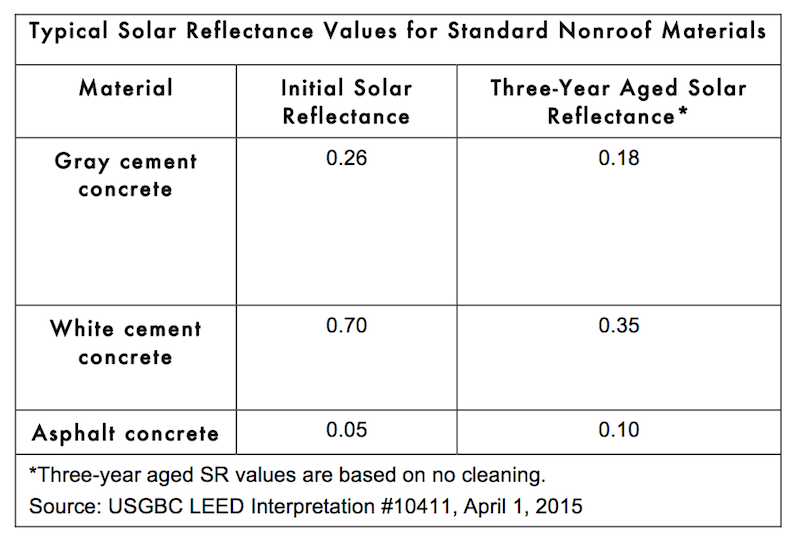This credit offers several different compliance paths to choose from, making it a very achievable credit for most projects. It’s common for teams to pursue the reflective materials option for roof and/or hardscape. Providing parking undercover is another popular option that’s highly achievable for projects that include a parking garage.
Teams also have the option to retain existing shade trees and plant new trees to shade paved areas onsite. Vegetated roofs contribute to this credit as well, if they use native or adapted plant species.
LEED Interpretations—so long?
A couple of LEED Interpretations that were available for LEED v4 projects have not yet been confirmed by USGBC for LEED v4.1 projects. We recommend using caution if relying on either of these Interpretations without checking with USGBC first.
- Interpretation #5370 allowed projects that provide NO parking at all to achieve one point under this credit.
- Interpretation #10411 allowed projects to use standard SR values for some materials (see the table on the LEED v4 credit page).
Standard solar reflectance (SR) values for concrete
Watch out—typical gray cement concrete does not meet the credit requirement by itself, as its typical SR default value is 0.26, less than the credit threshold of 0.33. If you are using gray concrete and hope for it to comply with a higher SR, you will need to test it. Most projects should not need to have their concrete tested if they’re also using other compliant nonroof and roof materials, since the weighted sum of nonroof and roof measures is often greater than or equal to the sum of project paving and roof area. Projects using large amounts of individual materials that don’t meet the minimum SRI levels will benefit from early design calculations to see if the weighted total will comply.
New guidance for measuring solar reflectance (SR)
In some instances, SR information may not be available for a given material. If your team is going to have a material tested, be sure the measurements are completed in accordance with ANSI/CRRC S100.
Parking spaces outside your boundary
All leased or owned parking used by the project must be included in your credit calculations for the parking under cover option—even parking that’s outside the LEED project boundary. So don’t ignore that adjacent parking garage!
SITES-LEED equivalency
SITES-LEED equivalency is not offered for this credit. The related SITES credit cannot be used to automatically earn this LEED v4.1 credit.
What’s New in LEED v4.1
- A new SR measurement standard has been added (ANSI/CRRC S100).
- The credit clarifies that functional/usable spaces located on roofs may meet the requirements of nonroof measures (as these spaces are poor candidates for highly reflective materials).
- Nonroof functional spaces may no longer be counted as a compliant strategy. These spaces must meet one of the other available nonroof measures.
- Vegetated roofs must have native or adapted plant species to count towards credit achievement.
- Credit calculations must include all leased/owned spaces used by the project, even if located outside the LEED project boundary.
- SITES-LEED equivalency is no longer offered for this credit.
- LEED Interpretations that were allowed under v4 may no longer apply to v4.1.
Should I Upgrade?
Probably not, as this credit is generally more difficult to achieve no matter which option you’re considering. We recommend reviewing the options carefully to determine how v4.1 would impact your specific project. Teams that want to use LEED Interpretation #5370 or #10411 should consider staying with v4, or confirming applicability for v4.1 projects first.
